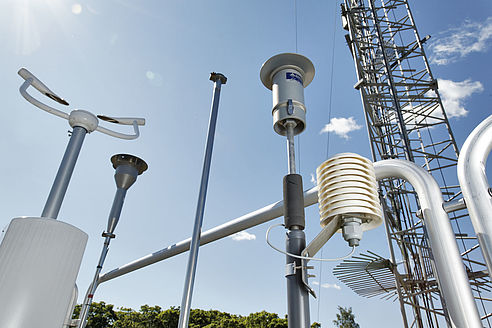HAQT in Details
The project took advantage of the latest scientific know-how and directly exploits the expertise obtained from, e.g., Tekes-funded (e.g. CITYZER, MMEA, RAVAKE) and EU-funded (e.g. ANYWHERE, HAREN, EDHIT, ERICHA) projects. Central to the project was the CITYZER platform developed within the Tekes-funded CITYZER open interface (AQ and nowcast) and business ecosystem -project, and the existing reference air quality instrumentation, which HAQT used as principal reference sources. The HAQT project employed the CITYZER platform to integrate observations, modeling and services seamlessly together. Further, the implementation of the HAQT as an extension of the CityzerDEMO (demo deployment of the CITYZER platform in the CITYZER project) enabled accounting for the impact of precipitation on air quality forecasts, as the CityzerDEMO system provided measurement data and forecasts on precipitation.
Dense network of AQ monitoring sites provided detailed information about pollutant concentrations over different parts of the metropolitan area and how people get exposed to them, e.g. in traffic environments or street canyons. Furthermore, a dense network revealed the heterogeneousness and fine structure of urban air quality, which in turn will improve the quality and adaptability of the used data fusion techniques. This information supports all societal decision making processes including public authorities, private businesses, housing and real estate companies as well as individual citizens. Thorough knowledge of air quality conditions is important also when planning to protect human health. For example, more accurate AQ data would allow exposure assessment for air quality health effect studies and to reduce diseases and costs related to poor air quality.
The HAQT project defined and suggested new digital services and products to support decision making processes related to air quality in cities. These services include, e.g., situational awareness pictures through sensor data fusion and diagnostics, early warnings and forecasts (0-48 h), which allow for mitigating human distress and costs due to poor air quality, and generally improve the resilience, health, and safety of the society.
The HAQT project, with its dense network of AQ monitoring instruments supplying the ENFUSER model, enhanced our understanding of the impact of different emission sources to air quality. The more AQ monitoring data are available for the modelling system, the more accurate information and prediction of the air quality it can produce. Distribution of the online AQ information to public increases the awareness of air quality situation and can improve the quality of life of sensitive groups in particular. Currently, Helsinki Region Environmental Services Authority HSY has fixed air quality monitoring stations in Helsinki that meet the strict quality objectives for monitoring set by the air quality directives. The new air quality instruments of the HAQT project offered the possibility to achieve more detailed spatial information about air quality in the Helsinki Metropolitan area by having a dense network of new AQ instruments in addition to these fixed stations.
The HAQT project aimed to enhance and support the export of environmental monitoring products and services of Finnish companies. Target countries were, e.g., China and other countries with AQ-related challenges. The target groups of the AQ services and products (e.g., public sector, real estate and energy companies, and distributors) and related business models were analyzed and developed in collaboration with local players (e.g. China) taking advantage of the pre-existing contacts by the FMI, UHEL and Vaisala Ltd. Service models were designed to account for and adapt to the special needs of different areas and customer groups.
The HAQT project provided the roadmap with recommendations for services and applications of the HAQT -like air quality network. This included assessment of export potential of the HAQT network with plausible destinations being China, India and other areas suffering from poor air quality.
HAQT project partners were Vaisala Ltd (air quality observation instrumentation and products), Pegasor Oy (Air quality instrumentation), HSY (urban services), Finnish Meteorological Institute (project coordination, site selection and installations, performance evaluation air quality research, simulations and forecasting), and University of Helsinki (air quality research and investigations, comprehensive observations).
The HAQT project were carried out in two stages. The first stage, carried out in 2017, concentrated on designing and building the necessary infrastructure for the project. This included investigation of the optimal locations for the new AQ instruments, installation and testing the performance of these instruments, integrating them with the CITYZER platform to take advantage of their data in the AQ modeling, making the necessary modifications to the CITYZER platform to meet the requirements of the HAQT project, and setting up a demo service to visualize the AQ measurement and forecast data over the map of the region. In addition, potential new AQ quantities for AQ monitoring were studied, and potential services for different customer groups mapped together with the stakeholders.
In the second stage,carried out in 2018, the benefits from the AQ network expansion were quantified, an ENFUSER road dust model developed, open access data interface implemented to serve the HAQT data to third parties, services and their impacts analyzed, a network-based emission monitoring tool developed, a roadmap for future AQ networks prepared, and business opportunities assessed. The two stages had separate budgets. With this investment the Helsinki metropolitan Air Quality Testbed (HAQT) project established a powerful toolbox with service potential of high societal impact highlighting the advanced technological and scientific level of the Helsinki Metropolitan and provincial region, as well as paving the way for new regional and export business opportunities.
